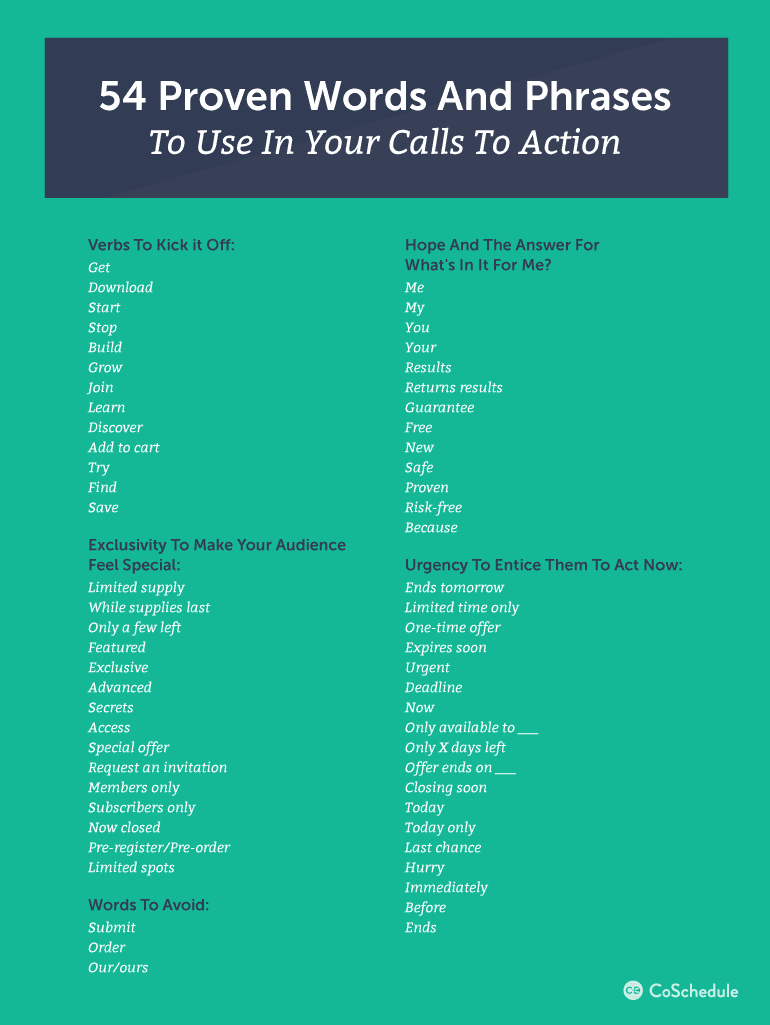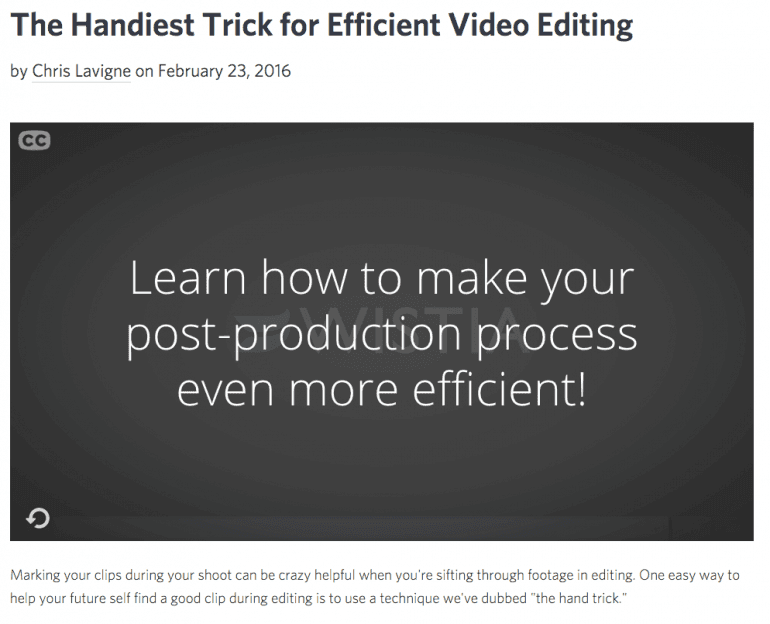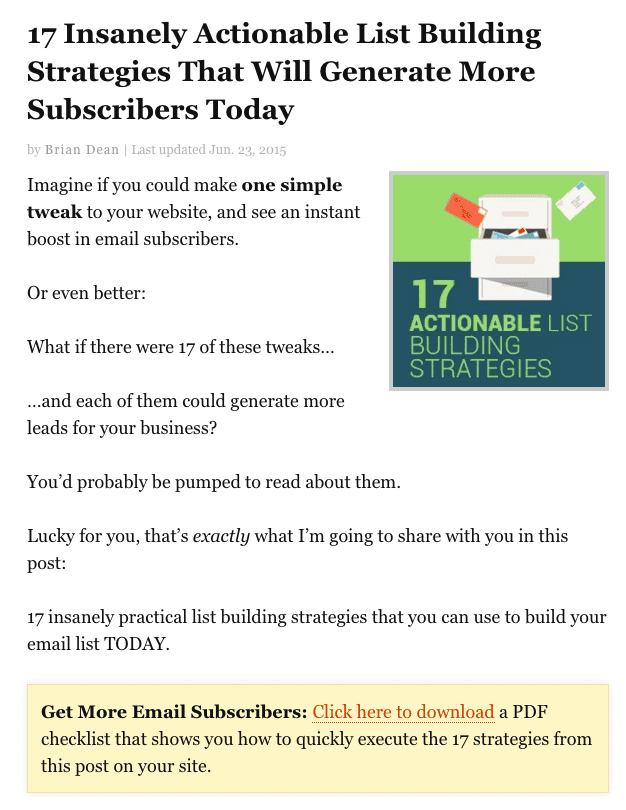How To Write A Call To Action In A Template With 6 Examples
 All of your content marketing success hinges on the bounce and the conversion. The two exist on a seesaw, the dreaded “bounce” on one side and “conversion” on the other.
And what is the fulcrum at the center of the two that will determine which way it will tip? Your call to action—aka your marketing CTA.
Your content marketing lives and dies based on the success of your CTA. It determines if people take your content and bounce out on their merry way, never to return, or if they leap for the bait and go further into your sales funnel. Knowing how to write a call to action that hooks your reader's interest is key to your content's survival.
Recommended: Call-To-Action Generator
All of your content marketing success hinges on the bounce and the conversion. The two exist on a seesaw, the dreaded “bounce” on one side and “conversion” on the other.
And what is the fulcrum at the center of the two that will determine which way it will tip? Your call to action—aka your marketing CTA.
Your content marketing lives and dies based on the success of your CTA. It determines if people take your content and bounce out on their merry way, never to return, or if they leap for the bait and go further into your sales funnel. Knowing how to write a call to action that hooks your reader's interest is key to your content's survival.
Recommended: Call-To-Action Generator
 Source
Source
Know how to write a #CallToAction? Here are 54 words and 6 examples that'll unlock your #creativity.
Click To TweetWhat Is A Call To Action?
 A call to action might be as simple as asking someone to:
A call to action might be as simple as asking someone to:
- Sign up for your email newsletter.
- Download free resources in exchange for an email address.
- Buy an ebook, coaching service, or your product.
Whatever form it takes, a call to action provides your reader with an actionable task.
Without a call to action, you're wasting your best efforts.
How To Write A Call To Action Using Exclusivity And The Undeniable FOMO
When it comes to a powerful motivator for your call to action, FOMO, or the fear of missing out, is hard to beat. This is about exclusivity, which generally works in two ways:- Only some get in. By only letting a few get in, you suggest that those who do are lucky, should be thankful, are special, are deserving—anything of this nature. This is about status, namely who’s in and who’s out. In order for this to work, you have to make something amazing enough that people want to be in on it.
- Anyone gets in, but with restrictions. Think of data rights management or DRM controls on ebooks and music. The product is available to anyone, but you need specific devices, tools, or access methods to use it. In this way, it's exclusive because you control how people use it and how they can share or spread it.
- Panic: “If I miss out, I’ll never know if this could have changed my life!”
- Greed: “I have to have everything.”
- Comparison: “I don’t want to be the only person without this!”
- Curiosity: “Could this possibly be as amazing as they describe?”
- Pride: “I got in and you didn’t. Ha ha.”
How To Use Exclusivity And FOMO In Your #CallToAction To Boost Conversions
Click To TweetHow To Put Exclusivity To Work In Your Call To Action
Exclusivity rides on one main idea: If you don’t do something now, you’ll never be able to do it again. You can hint at exclusivity through the words in your call to action. Think of any word or phrase that suggests now:- Last chance
- Limited supply
- Only a few left
- Ends tomorrow
- Limited time only
- One-time offer
- Expires soon
- Urgent
- Deadline
How To Write A Call To Action Using Hope As A Motivation
Fear isn’t the only way to get people to act, though it's one of the most powerful. Hope can do the trick, too. First you need to create a sense of desperation. Illustrate just how big a problem your readers have, and the hope to change it will suddenly make sense. While driving around town and checking errands off of my to-do list this past weekend, I took note of the billboards and signs outside of the stores and restaurants. I said to my friend, who was with me, that there was absolutely nothing that I needed, yet here I was, buying stuff.“I wouldn’t be dissatisfied with my life and possessions if they didn’t tell me it ought to be so,” I said, a bit annoyed. “You can’t sell to people who aren’t dissatisfied,” my friend replied.With dissatisfaction comes hope. Or it should, if you’re writing your call to action correctly.
How To Leverage Hope With Your Call To Action
To tap into hope, you first must suggest hopelessness. By that, I mean you must show the reader that there is a problem, it’s a serious one, and they have it. And then you provide the solution and the hope.“You’ve tried everything to lose weight, but nothing worked,” is easily countered with, “Try this safe and proven method that returns results every time, risk free!”
In this call to action example, you assure the reader by using the words “safe” and “risk free”, and give them hope by suggesting it's “proven” and “returns results”. Big problem. Big hope. Once you’ve established this pattern, end with your simplified call to action. “Start now and lose 10 pounds in your first month.”So ... What Are Those Call To Action Words That Get People To Act?
Is it possible that certain words get more conversions than others? It's a good question that has some research behind it—to an extent. So I took a look at five well-researched articles to pull together a big list of call to action words that will help you get more email signups, trials, and sales. This data comes from five researched articles, and even includes some words that have helped CoSchedule get as much as a 27% conversion rate from our own calls to action:- Backlinko's research on building email lists
- Sprout Social's research on call to action phrases
- WishPond's research on words to use in call to action buttons
- Unbounce's research on call to action buttons
- Unbounce's research on conversion rate optimization
- CoSchedule's research from our own landing pages and blog posts
 Now, many of these sources suggest testing your own calls to action on your blog and website to see what words perform best with your audience. That is great advice you can put into practice by using a tool like Visual Website Optimizer. Start simple:
Now, many of these sources suggest testing your own calls to action on your blog and website to see what words perform best with your audience. That is great advice you can put into practice by using a tool like Visual Website Optimizer. Start simple:
- Write two powerful calls to action you will A/B test against one another.
- Set up the test with Visual Website Optimizer.
- Give it a week and analyze the data.
54 Powerful Words To Test In Your #CTAs
Click To Tweet6 Call To Action Examples To Help You Write Better CTAs Than Ever
Call to action examples are everywhere, so where would you start? I figured we'd take a look at a few of the top companies in the world according to Fortune's 500 list (there has to be a reason they're so successful, right?), then dive in to some specific examples that are a bit more content marketing related. Let's do this.1. Learn More With Apple
Like the simplicity of their products, Apple keeps their calls to action short, clean, and to the point. Learn more and Trade up to a new iPhone are unmistakable in letting Apple's audience know exactly what they'll see after they click through the call to action. Apple also doesn't clutter the design: There are clearly only two options to help their users focus on making a decision to click quickly and easily.
Learn more and Trade up to a new iPhone are unmistakable in letting Apple's audience know exactly what they'll see after they click through the call to action. Apple also doesn't clutter the design: There are clearly only two options to help their users focus on making a decision to click quickly and easily.
2. Save With CVS
While the design is super busy compared to Apple's example (do I click on Save with Our App, App Store, Google Play, or on the phone itself?!), CVS focuses on the value proposition in their call to action. Save with Our App focuses CVS' audience on the perceived benefit of using the tool, which connects into hope to resolve the dissatisfaction of spending so much money.
The headline here—Unlock extra savings with app-only deals!—also suggests exclusivity, that you can only experience those benefits if you get the app. They also include the word exclusive in the description, which is a powerful motivator for the fear of missing out.
Save with Our App focuses CVS' audience on the perceived benefit of using the tool, which connects into hope to resolve the dissatisfaction of spending so much money.
The headline here—Unlock extra savings with app-only deals!—also suggests exclusivity, that you can only experience those benefits if you get the app. They also include the word exclusive in the description, which is a powerful motivator for the fear of missing out.
3. Rely On The Visual Like Amazon
Who said you had to write a call to action? The behemoth Amazon focuses on compelling imagery to entice action. In this example, there is really no traditional call to action that usually begins with a verb. However, Amazon does rock some powerful words with the visual: Now and Limited time offer. Talk about inducing urgency and appealing to the fear of missing out.
The visual tells the rest of the story, helping Amazon shoppers envision themselves in front of an amazing TV with a bowl of popcorn and a couple glasses of champaign.
Would you like to chillax like that, too? Heck yes, you would. And that's why the visual creates a powerful call to action.
It's noteworthy to mention this: Amazon doesn't even show the product they're selling (other than the remote) and focuses the visual mostly on the experience you'll feel when you click through the call to action to purchase it. People don't buy products, they buy experiences. And that's why Amazon crushed it with this call to action example.
In this example, there is really no traditional call to action that usually begins with a verb. However, Amazon does rock some powerful words with the visual: Now and Limited time offer. Talk about inducing urgency and appealing to the fear of missing out.
The visual tells the rest of the story, helping Amazon shoppers envision themselves in front of an amazing TV with a bowl of popcorn and a couple glasses of champaign.
Would you like to chillax like that, too? Heck yes, you would. And that's why the visual creates a powerful call to action.
It's noteworthy to mention this: Amazon doesn't even show the product they're selling (other than the remote) and focuses the visual mostly on the experience you'll feel when you click through the call to action to purchase it. People don't buy products, they buy experiences. And that's why Amazon crushed it with this call to action example.
People don't buy products, they buy experiences. Include the experience in your #CTA.
Click To Tweet4. Code School Shows Calls To Action Don't Have To Be Super Formal
Wondering how to apply calls to action into your blog posts? Write a post that helps your readers do something without you, then when you can help them do it even better, let them know. Code School helps people learn how to code. So when they wrote a post called Why Python? that covered reasons to learn and use the language, they ended the post with a call to action to learn more through the courses Code School offers.
The call to action appears as the last paragraph in the blog post, and invites readers to Check out a couple new courses. It's simple, informal, yet informational to teach their audience about the possibilities Code School offers to help their readers improve.
Code School helps people learn how to code. So when they wrote a post called Why Python? that covered reasons to learn and use the language, they ended the post with a call to action to learn more through the courses Code School offers.
The call to action appears as the last paragraph in the blog post, and invites readers to Check out a couple new courses. It's simple, informal, yet informational to teach their audience about the possibilities Code School offers to help their readers improve.
5. Wistia Embeds Calls To Action In Videos
Do you embed videos in your blog posts? With Wistia, you can add a Turnstile into your video to collect email leads during video play, and you can also include a written call to action and link to related content at the end of your video. Turns out, you can also write a call to action right into your YouTube videos, too, if you're not a Wistia user. Anyway, this call to action example shows up at the end of a video that explains one element about making post-product process simpler—something Wistia's audience cares a lot about. Wistia then links to more information on the topic to help their viewers learn more about post-production—which is a part of the video process Wistia as a tool can help make more efficient.
The video appears in lieu of a traditional blog post header graphic. That means Wistia's audience sees a video right away (which also likely boosts on page time and engagement quite a bit), Wistia shows their quirky brand personality, and they display a strong call to action immediately.
This is a great example of leading an audience deeper into the funnel from inbound marketing to demand generation content that positions Wistia as the solution to the problem. Brilliant.
Anyway, this call to action example shows up at the end of a video that explains one element about making post-product process simpler—something Wistia's audience cares a lot about. Wistia then links to more information on the topic to help their viewers learn more about post-production—which is a part of the video process Wistia as a tool can help make more efficient.
The video appears in lieu of a traditional blog post header graphic. That means Wistia's audience sees a video right away (which also likely boosts on page time and engagement quite a bit), Wistia shows their quirky brand personality, and they display a strong call to action immediately.
This is a great example of leading an audience deeper into the funnel from inbound marketing to demand generation content that positions Wistia as the solution to the problem. Brilliant.
6. Create Content-Specific Calls To Action Like Backlinko
Have you seen blog posts that offer something free in exchange for your email address? Somewhere along the lines, marketers started calling those things content upgrades. And they are a super smart way to include a call to action in every blog post to turn the traffic you get into email subscribers. In this call to action example from Backlinko, Brian Dean includes a written CTA in the introduction of his blog post. That is brilliant because a majority of your audience will read the first 100 words of your post, then maybe skim the rest.
Anyway, this call to action is very smart because it relates specifically to the content at hand and not just a generic give-me-your-email-address kinda CTA. Brian relates directly to the challenge his readers want to resolve by writing Get More Email Subscribers, then he uses a powerful word with download.
He also promises that what his readers will get behind the call to action will help them quickly execute the 17 strategies from this post, which is very important for the Backlinko blog in particular because Brian creates such long-form content. This way, he captures the interest of the too-long-didn't-read (TLDR) audience while also turning them into email subscribers.
In this call to action example from Backlinko, Brian Dean includes a written CTA in the introduction of his blog post. That is brilliant because a majority of your audience will read the first 100 words of your post, then maybe skim the rest.
Anyway, this call to action is very smart because it relates specifically to the content at hand and not just a generic give-me-your-email-address kinda CTA. Brian relates directly to the challenge his readers want to resolve by writing Get More Email Subscribers, then he uses a powerful word with download.
He also promises that what his readers will get behind the call to action will help them quickly execute the 17 strategies from this post, which is very important for the Backlinko blog in particular because Brian creates such long-form content. This way, he captures the interest of the too-long-didn't-read (TLDR) audience while also turning them into email subscribers.
 To top it off, Brian targets another call to action for the 20% of his audience that makes it through the entire blog post to the very end. This time, he lets the visual speak for itself with the power word download, and includes the emotional word free to describe his content upgrade.
To top it off, Brian targets another call to action for the 20% of his audience that makes it through the entire blog post to the very end. This time, he lets the visual speak for itself with the power word download, and includes the emotional word free to describe his content upgrade.
6 #CallToAction Examples That Will Unlock Your #Creativity! #blogging
Click To TweetPut It All Together: How To Write A Call To Action With A Compelling Structure
 No matter what motivation you use (fear or hope), there are some common ways that you should use when structuring your call to action.
No matter what motivation you use (fear or hope), there are some common ways that you should use when structuring your call to action.
1. Start with verbs.
Verbs are the action words that make it clear to readers what you want them to do. Instead of saying, “Ready to get started?” simplify it to “Get started now” or “Start saving now”. Some verbs are stronger than others. This has to do with the cacophony of the word (hard K, G, D sounds) coupled with the strength of the action suggested in context. The word “buy” feels stronger and more urgent than “purchase”. “Get your copy” is more cacophonous and powerful than “Download your ebook”. Starting with verbs means starting phrases and sentences, sure, but also the placement of links and call to action buttons. They come first (or nearly first) and should be prominent. Buttons to buy or sign-up should be above the fold, no scrolling required. They should be before the long chunk of explanatory text.Verbs are words of action, and that’s exactly what you want from your readers.
Click To Tweet2. Take it easy on filler words.
Adverbs and adjectives can get in the way of the action you want your readers to take. You should have already done the work of convincing people to take the action before presenting your call to action to them through blog post or landing page copy. Try your best to avoid words ending in -ly. “Click here” is better than “Click here quickly.” There are exceptions, though. For example, you might hint at exclusivity by saying “Get your custom ebook now” instead of just “Get your ebook”.3. Keep things simple and brief.
Use words that are simple, common, and not too long. This isn’t because you think your reader isn’t smart enough to handle anything else, but because you’re trying to prod base emotions. You don’t want anything to get in the way of those simple emotions, particularly requiring readers to consider complex thought processes or scenarios which could distract them or lead them down a path of thought away from taking action. Avoid buzzwords, jargon, and any word that feels “empty” and can be ignored by the reader. If you use enough ignorable words in your call to action, your entire call to action runs the risk of being ignored.Steps for a successful #CTA: verb > clarity > simplicity > request.
Click To Tweet4. Make the request simple, too.
It’s not just the language of the request that you need to make simple, but the request itself must be easy. One or two clicks to completion. As little pain as possible. If you need more information than a name and email, try to break it up so you capture that email first, get the user into the purchase or into their account, and then collect the rest later. The reason is that you don’t want to give your reader time to change their mind. I don’t know how many times I’ve been at a big box store and, because of too few checkout lanes available, seen people abandon full carts in line and walk out the door. It’s the same with your call to action.The more complicated you make it for readers to complete it, the more likely they’ll find a way to change their mind or forget the driving reason you just convinced them they needed to take action.
“Buy now!” doesn’t feel like “now” if you make them fill out lots of information, answer a small survey, and click on a reply email to verify. That feels like buying later, and it brings into question the urgency you insisted was necessary to get a reader to take action.How To Write A Call To Action In A Template With 6 Examples That Will Boost Your Creativity
Click To Tweet

